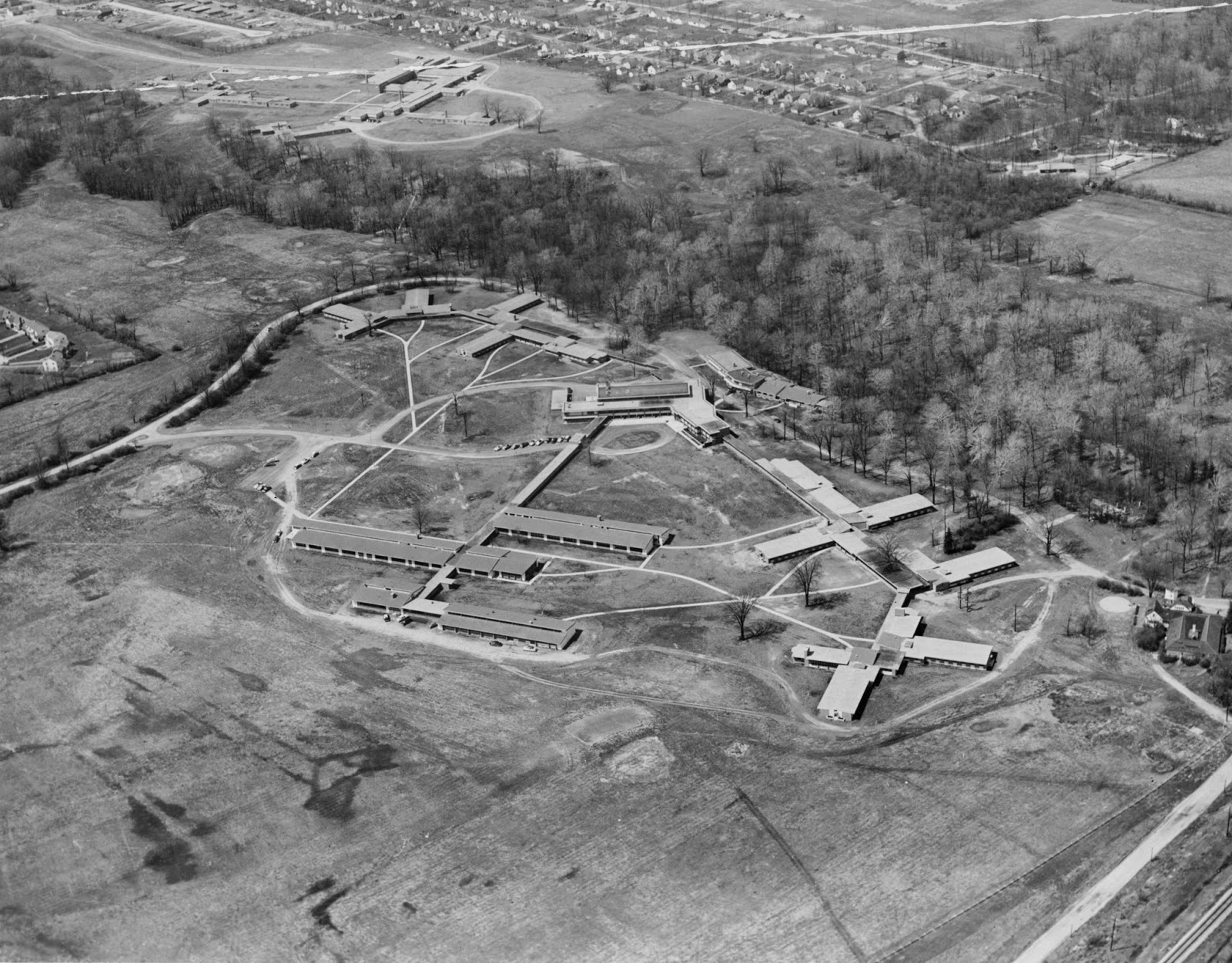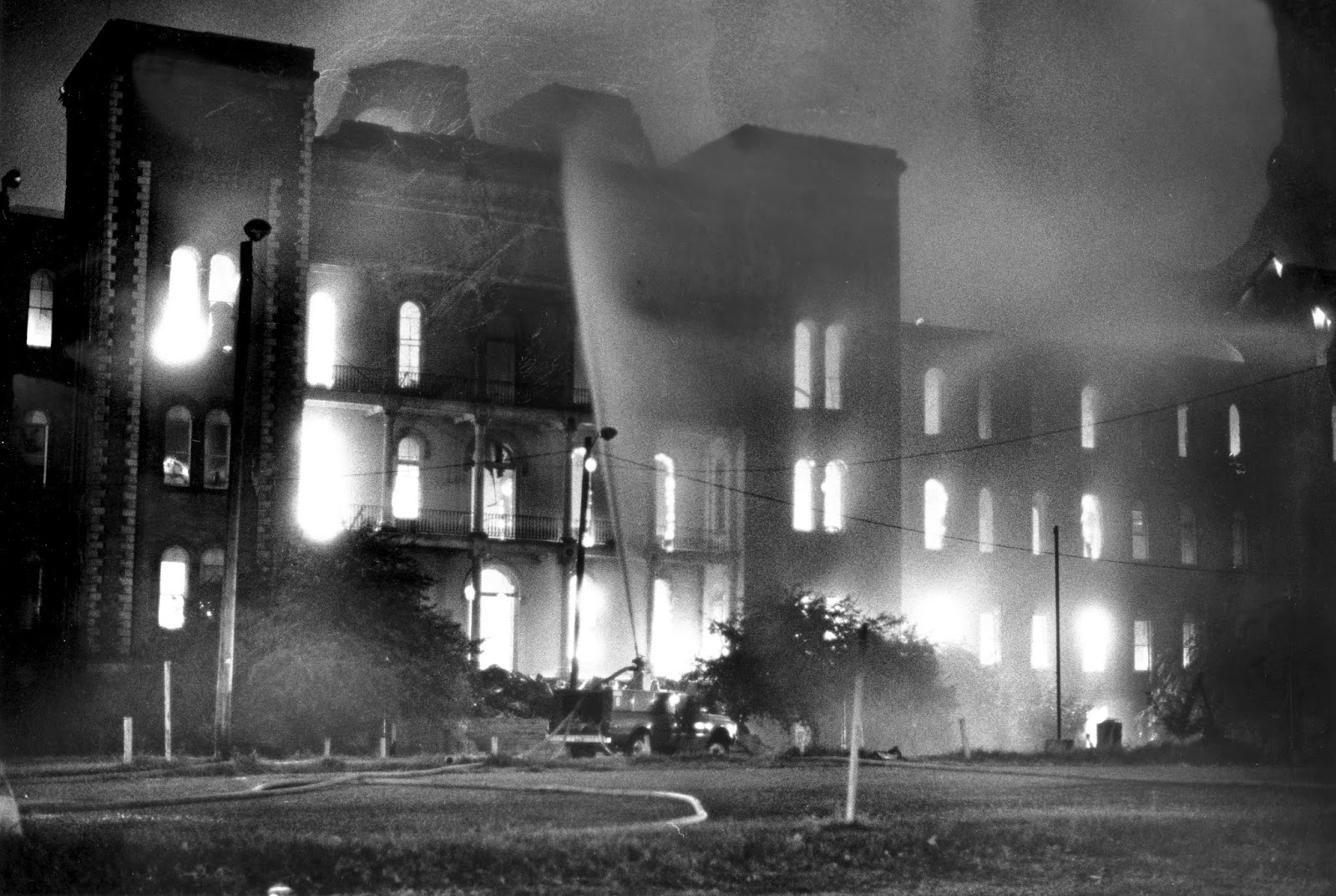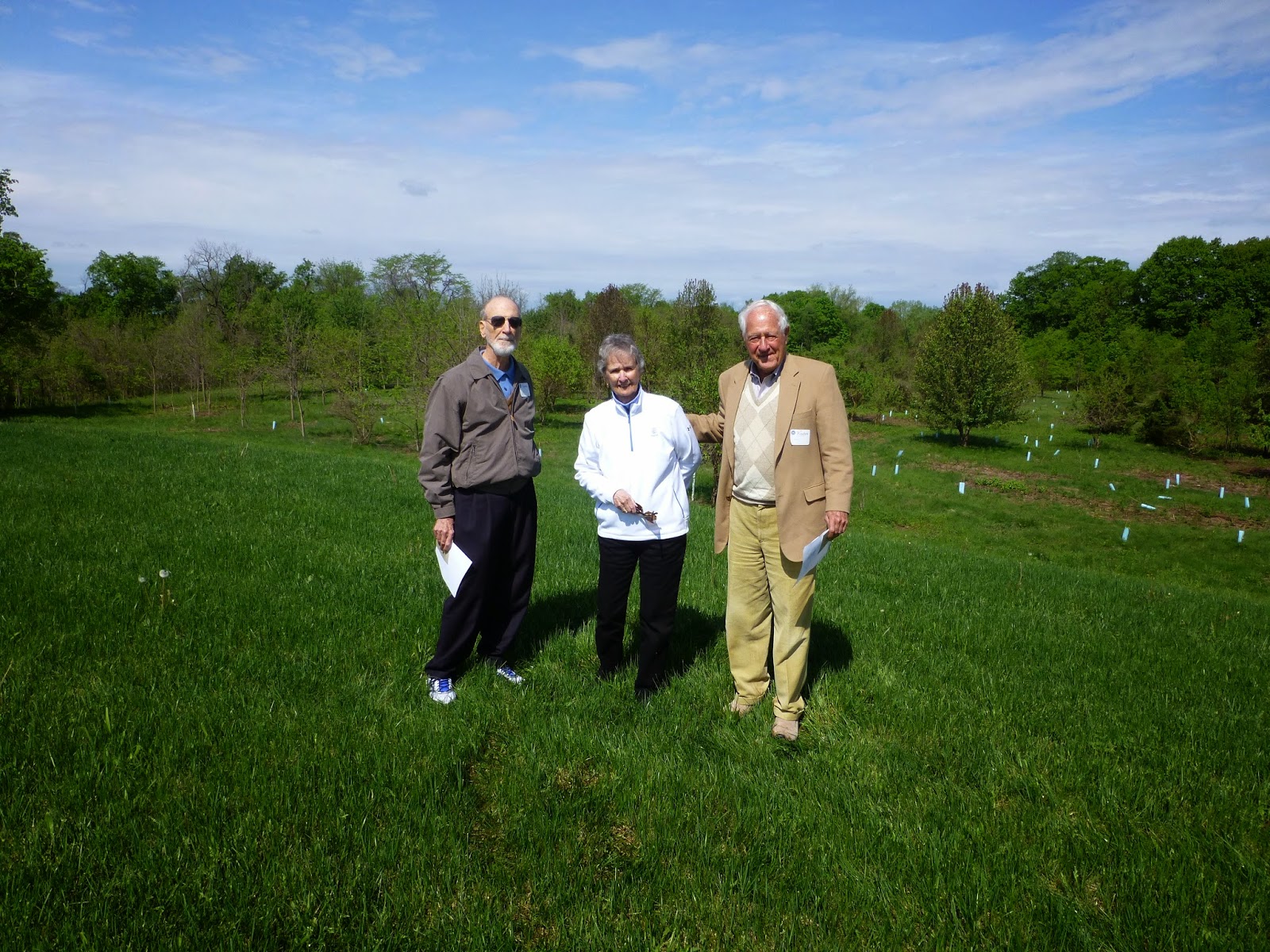Chapter 19: Final Shots
Shirley Aisel (now Shirley Edler) preparing to tee off on Wyandot's par 3 5th
Her summer routine rarely varied. Out of the house located in the south end of town mid-morning; a mile walk to the stop where she would board the north-bound bus; a 25 minute ride through downtown and up High Street- the city's primary north-south artery- to the Morse Road stop; then another mile hike east on Morse Road to the golf course. As 14 year old Shirley Aisel would stroll up the long curving driveway to the clubhouse, she might pause for a moment to eye the daily fee golfers putting on the 7th green or executing their pitch shots to the par 5 6th hole. Having finally arrived, Shirley would check in at the pro shop where she would be greeted by affable John Buchanan, who had served as Wyandot's pro-manager since the city took over operating the course in '47. If she had an extra quarter, she would treat herself to a "brown cow" (ice cream with root beer) in the clubhouse before grabbing her golf bag and heading over to the practice area by the railroad tracks. The young junior would usually spend hours working on her game and shagging her own balls. The girl would sometimes share practice time with young Dick Rhyan, who later made a name for himself on the PGA tour. Shirley enjoyed the routine of practice, but relished playing the course most of all. It was so beautiful with its wooded ravines and ponds! But those woods spelled trouble for off-line shots, and she learned early the virtues of straight hitting. Comfortable in her Wyandot golf cocoon, Shirley Aisel improved rapidly in the summers of '49 and '50. She was good enough to play on the boys' team at South High School. In her golf reverie, Shirley remaining relatively oblivious to the political machinations then threatening her beloved course.
It had not been the teenager's idea to take up golf. Shirley was given a rather firm push in that direction by her father, Glenn "Doc" Aisel. Doc had visions of his daughter playing on the LPGA tour, and insisted that she practice. Doc had come up the hard way. He was one of eleven children. In what was retrospectively a rather remarkable coincidence, Doc's father and brothers labored in the Marble Cliff Quarries excavating stone for John Kaufman's company. Instead of working in the quarry, Doc took up caddying at Scioto. He would walk down the middle of the fairway with all four bags (they were smaller then) and the Scioto members would walk over to Doc to retrieve their clubs. Having later secured gainful employment as a tool and die maker, Doc found time to take up golf himself. He became a very good amateur, ultimately winning the club championship at Indian Springs. One of Doc's best golfing buddies was Al Marchi, who had briefly served as Wyandot's professional. Doc and Al would team up in pro-ams all over Ohio and nearby states. When Shirley was a pre-teen, she recalls that the dapper Marchi was a frequent visitor to the Aisel household.
Al Marchi with young, dimpled Shirley Aisel
During the 1949 season, John Buchanan, unlike Shirley Aisel, was well aware of Wyandot's impending closing. Presumably, he could have gone through the motions of collecting greens fees, and spent most of his time looking for his next employment. Instead, he actively marketed the course, and municipal golfers continued to show up in droves. Buchanan also scheduled Wyandot for seven competitive tournament events during the '49 season. The course held its last statewide championship in June, 1950 when it hosted the Ohio Public Links championship. 22 year old Daytonian Jack Zimmerman prevailed 1 up over perennial contender Val Chiaverini in a rain-drenched final match.
With the receipt of the State's notice to the City demanding that it vacate the premises in November, 1950, it seemed certain that no more golf would be played at Wyandot. But John Buchanan launched his own private battle to keep the course alive a little longer. During the winter of '50-'51. Buchanan "consulted with the city administration, the State, and the exponents of the blind and deaf schools." It was the pro's assessment that the "schools won't be needing more than a fraction of the Wyandot acreage for the next couple of years. Why not leave the rest of the course just as it is until the land is needed?"
This argument certainly struck a chord with Mayor Rhodes and city recreation director Nick Barack. Twin Rivers was barely playable, and Raymond Memorial would not be ready for play until 1953. The City still needed a golf course to bridge the gap until Raymond was opened. After much negotiation, the schools finally relented and granted the City a two year lease. To avoid the State's construction work, it would be necessary to reroute several holes, eliminate others, and create some new shorter ones. It fell to Buchanan to figure out a workable redesign. Ultimately, he was forced to shorten the course from 6433 yards to 5775 yards. The course's par would be reduced from 71 to 68. Gone was the course's iconic dogleg 10th hole that had bedeviled nearly all except for Denny Shute who would neatly cut the dogleg with a high spoon over the trees. Five new greens and six new tees were constructed. Seeding of the new fairways and greens was delayed until late in the spring of '51 due to foul weather and a "labor shortage so severe that John threatened to do the work himself." Buchanan and wife Helen "scraped together what they could to refurnish the clubhouse. They got a piece of furniture from one city building and another there, making whatever repairs were needed, and finally again had a passable locker room." Buchanan tried to put he best face on things saying that the "new 32-36 -68 par would be considerably tougher than was the old 36-35-71." And the course's signature hole- the picturesque par 3 5th was still intact!
Even the shortening of the course did not dissuade Buchanan from showcasing Wyandot in 1951. In August, the course hosted the Columbus Public Links Championship which was won by Barney Hunt. The former district champion defeated Bill Podolski in the final 2 and 1. But the bastardized layout was not as attractive as the old course, and as a result, the City recorded only 8,428 greens fees for the year.
Despite public awareness that its closing appeared imminent, the course continued to serve as the training ground for aspiring and talented young players. One of them was Bill Muldoon who became a junior member in a most extraordinary manner. On a lark, the 14 year old entered a hole-in-one contest at Olentangy Driving Range on Dodridge Avenue in June of 1952, and won it with a shot that settled 10 inches from the hole. His prize was a season pass to what was left of Wyandot- and a golf glove! Young Muldoon seized on what he viewed as a golden opportunity to develop his game, playing and practicing at Wyandot all summer long. According to brother Sam, Bill, like Shirley Aisel, was busing daily to Wyandot. His journey to the course required three bus rides each way. His golfing summer at Wyandot paid off. Muldoon became an exceptional junior player winning the state junior and Jaycee titles two consecutive years. That second year he bested young Jackie Nicklaus by one shot in both tournaments. In a February 2012 article in Golf World, Kaye Kessler remarked that before Jack could really think about beating Bobby Jones' records, "he had to beat Bill Muldoon." Bill's distinguished amateur record included three scholastic championships and a stint as a three year letterman on the golf team at Ohio State. Perceiving that he could not keep up with the likes of Jack long-term, Bill did not pursue a career in golf, and became a successful dentist.
Shirley Aisel Edler is quite sure that she and her dad were the last group to play at Wyandot in the late fall of 1952. She recalls her sadness to see the course on its last legs, just a shadow of what it had once been. But if Shirley and Doc were the last ones to play there, a more appropriate pairing to close the course could not be found. They were both outstanding players, and Doc's father had been associated with John Kaufman, the father of Elks'-Wyandot. Shirley would win 15 Scioto Country Club championships between the years 1969 and 1995. She would take home several state senior women's championship trophies. Mrs. Edler still competes with success on Scioto's golf team. Elks'- Wyandot, labeled by the scribes decades earlier as the "Maker of Champions," had made its last one!
Shirley Edler still wakes up at night dreaming of old Wyandot. Instead of counting sheep, she tries to recall the holes of both the original course and John Buchanan's shortened redesign. Clearly there was an unforgettable quality to the course that the construction of the two schools could not eradicate. Golfers still with us who had the pleasure of playing Wyandot, like Shirley, Dwight Watkins, Bill Amick, Kaye Kessler, Fred Balthaser, and Sam Muldoon would agree with the Dispatch's Bill Needham's tribute to Elks'- Wyandot. That esteemed sportswriter penned that the course was "a delight to play," and that it "had calmness and dignity combined with a suggestion of the joy of living. There were few courses like it."
Acknowledgements: Shirley Aisel Edler, Sam Muldoon, archives of the Columbus Citizen and Columbus Dispatch contained in the Columbus Metropolitan Library; Columbus Memory, Scripps-Howard Newspapers/Grandview Heights Public Library/photo.org collection
Epilogue:
By the mid-fifties, it was becoming difficult to discern that a golf course had once occupied the campus now occupied by the two schools. The School for the Deaf, located to the south of the ravine fully covered the old clubhouse area. The School for the Blind to the north of the ravine removed any vestige of several holes on the back nine. Both schools remain in operation to this day.
School for the Blind (top of picture); School for the Deaf (bottom of picture)
In 1955, Harold Kaufman died at age 65. Harold, who had succeeded his father John as the chief executive of Marble Cliff Quarries had worked with Donald Ross on the course's "construction committee" at the time of the course's building in 1922, and hit the tee shot that opened the course in '23. Curiously, his obituary made no mention of his involvement with Elks'-Wyandot or his honorary lifetime membership in the B.P.O.E..
Nor are there many remnants left of the Kaufman holdings. The Marble Cliff Quarry is now largely dotted with housing. Another of John Kaufman's companies, Claycraft Brick & Mining closed up long ago. A dozen years ago, a blogger recorded the company's derelict remains, Mountainous piles of bricks and abandoned plant buildings were there then, but even those are now gone.
John Kaufman's beautiful home on Bryden Road was demolished as well. A square brick apartment building of no particular significance sits there now.
The dire warning that the ancient School for the Deaf was a disaster waiting to happen finally came to fruition in 1981. A spectacular fire reduced much of the neo-gothic structure to ruins.
1981 fire at the former School for the Deaf
The remaining portion of the old school has recently been repurposed once more for use as a school. The Catholic church operated Christo Rey Columbus High School, features a national educational program focusing on professional work study programs for its students.
The lodge homes of the B.P.O.E. have likewise disappeared. The building that served as the headquarters until 1915 has been replaced by the Columbus Commons parking garage.
The Frank Packard-designed lodge home formerly located on Broad Street, for which John Kaufman served as chair of Lodge 37's building committee, has been long-since razed. The Midland Building is there today.
While many of the buildings and businesses of the Elks'-Wyandot era have vanished, several of the folks who played the course are alive, very well, and still playing excellent golf. On a crisp, sunny May morning, with the kind cooperation of officials from the Schools for the Deaf and Blind, I set up a date with three of them to visit the old course. All had made a distinctive mark in golf. Bill Amick, a Wyandot Country Club caddy who became a junior member once the course became municipally owned, visited from his home in Florida. Bill is past-president of the American Society of Golf Course Architects. He has spent his entire career designing and building golf courses. His entrée into golf course architecture began when his boss on the greens crew at Ohio State, Elks'-Wyandot's longtime greenkeeper Lawrence Huber, recommended Bill for a graduate program in agronomy at Purdue University. The aforementioned Shirley Aisel Edler was on hand too. Her 15 club championship victories at Scioto have cemented her stature in the game. Rounding out the threesome that day was the irrepressible Dwight Watkins. Dwight's father Cy had been a member at Wyandot until the club disbanded. Dwight had caddied there and played the course many times. Both father and son became Brookside members in 1948. Dwight is the club's member of longest standing. He is a former club champion at Brookside. Dwight expects to shoot his home club course in fewer strokes than his age of 88 every time he tees it up.
from left: Bill Amick, Shirley Edler, and Dwight Watkins
They exuberantly scampered around the grounds with nearly the zest they would have exhibited over old Wyandot more than 60 years ago. Golf had certainly helped keep these three young! I thought it would be nice if they each hit a ceremonial shot. Employing a hickory shafted niblick I supplied for the occasion, Bill, Dwight, and Shirley, all displayed timeless form in striking solid pitches to the general area of what had once been the 6th green.
The western portion of the School for the Deaf's campus still has a lovely vista that provides a reminder of the beauty that was once the hallmark of the golf course. Below, Bill, Shirley, and Dwight stand on a promontory from which, many years ago, they would have been executing downhill pitches to Wyandot's third green.
Elks'-Wyandot disappeared in 1952. While its Ross-designed golf course was certainly memorable, its greatest legacy is the golfing ambassadors and their progeny which it produced. Amick, Edler, and Watkins are great examples, but there were many more. Denny and Hermon Shute, Johnny and Judith Florio, Glenn "Doc" Aisel, Sam and Bill Muldoon, Glen Bishop, Lawrence and Jim Huber, Francis Marzolf, Ellen Marzolf Hallerman, Frank Marzolf, Glen Bishop, Mike Hurdzan, Jr. and Sr., Bill and Chester Margraf, Dick Rhyan, Dick Gordin, Fred Balthaser, Al Marchi, John Buchanan, Sally Elson, Blanche Sohl, Mel Carpenter, Mrs. Thornton Emmons, Kaye Kessler, Glen Bishop, Byron Jilek, Ray Heischman, Herb Bash, James Reston, Bob Kepler, Jim Rhodes, Lloyd Mangrum, Lloyd Gullickson, and of course, John and Harold Kaufman and Donald Ross played significant roles on the Elks'-Wyandot stage and elsewhere in the golfing world. Their contributions continue to have a positive impact on golf and those they inspired.
Acknowledgements: Dwight Watkins, Shirley Aisel Edler, Bill Amick, www.forgottenoh.com
archives of the Columbus Citizen and Columbus Dispatch housed in the Columbus Metropolitan Library; Columbus Memory , Scripps-Howard Newspapers/Grandview Heights Public Library photo.org collection http://photohio.org




















Lisa, thanks for this - Is there any way to get a larger, easier-to-read copy of the Wyandot course? Cathy (tennistyme@gmail.com)
ReplyDeleteThis comment has been removed by the author.
ReplyDelete